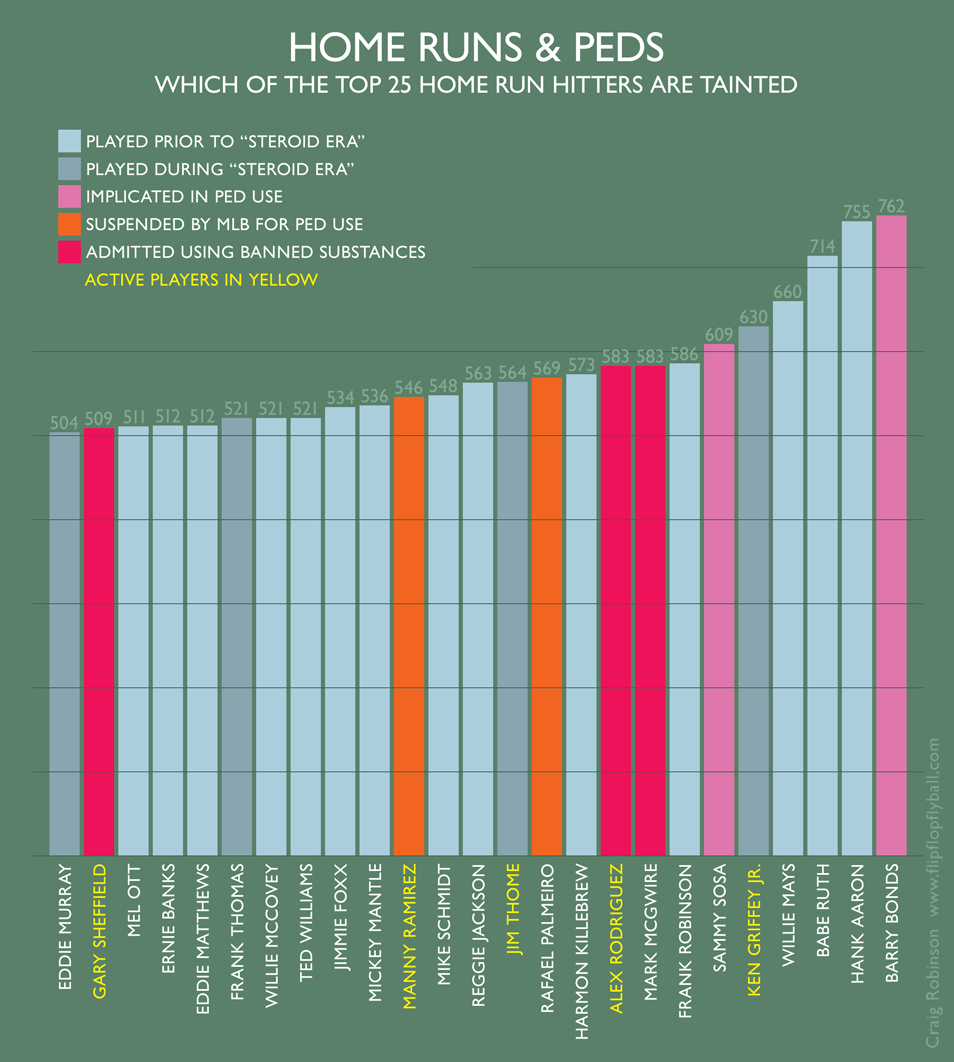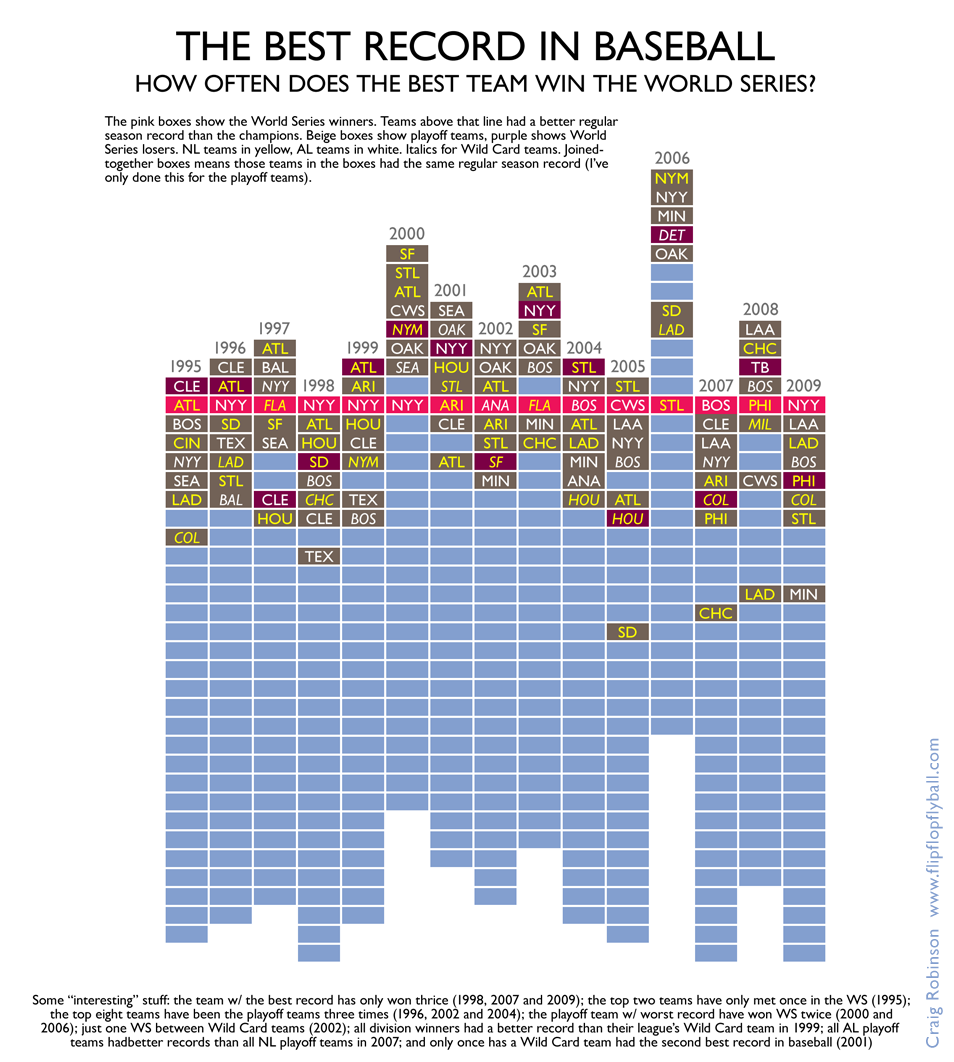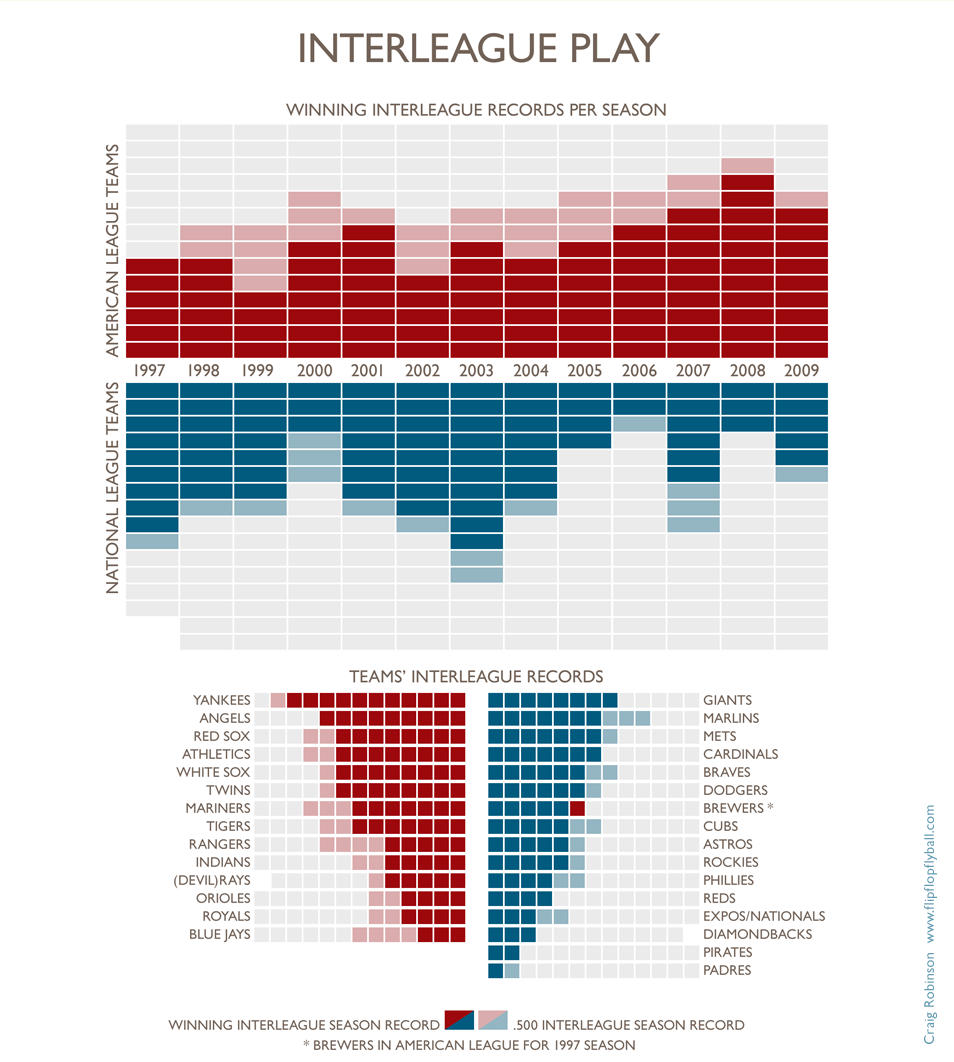TITLE: Baseball, Graphics, Patterns, and Simplicity
AUTHOR: Eugene Wallingford
DATE: April 08, 2010 8:56 PM
DESC:
-----
BODY:
I love
these graphs.
If you are a baseball fan or a lover of graphics, you will,
too. Baseball is the most numbers-friendly of all sports,
with a plethora of statistics that can extracted easily
from its mano-a-mano confrontations between pitchers and
batters, catchers and baserunners, American League and
National. British fan Craig Robinson goes a step beyond
the obvious to create beautiful, information-packed graphics
that truths both quirky and pedestrian.
Some of the graphs are more complex than others.
Baseball Heaven
uses concentric rings, 30-degree wedges, and three colors
to show that the baseball gods smile their brightest on
the state of Arizona. I like some of these complex graphs,
but I must admit that sometimes they seem like more work
than they should be. Maybe I'm not visually-oriented in
the right way.
I notice that many of my favorites have something in common.
Consider this chart showing the intersection of the game's
greatest home run hitters and the steroid era:
 It doesn't take much time looking at this graph for a baseball
fanatic to sigh with regret and hope that Ken Griffey, Jr.,
has played clean. (I think he has.) A simple graphic, a
poignant bit of information.
Next, take a look at this graph that answers the question,
how does baseball's winningest team fare in the World Series?:
It doesn't take much time looking at this graph for a baseball
fanatic to sigh with regret and hope that Ken Griffey, Jr.,
has played clean. (I think he has.) A simple graphic, a
poignant bit of information.
Next, take a look at this graph that answers the question,
how does baseball's winningest team fare in the World Series?:
 This is a more complex than the previous one, but the idea
is simple: sort teams by win/loss record, identify the
playoff and World Series teams by color, and make the World
Series winners the min axis of the graph. Who would have
thought that the playoff team with the worst record would
win the World Series almost as often as the the team with
the best record?
Finally, take a look at what is my current favorite from
the site, an
analysis of interleague play's winners and losers.
This is a more complex than the previous one, but the idea
is simple: sort teams by win/loss record, identify the
playoff and World Series teams by color, and make the World
Series winners the min axis of the graph. Who would have
thought that the playoff team with the worst record would
win the World Series almost as often as the the team with
the best record?
Finally, take a look at what is my current favorite from
the site, an
analysis of interleague play's winners and losers.
 I love this one not for its information but for its stark
beauty. Two grids with square and rectangular cells, two
primary colors, and two shades of each are all we need to
see that the two leagues have played pretty evenly overall,
with the American League dominating in recent years, and
that the AL's big guns -- the Yankees, Red Sox, and Angels
-- are big winners against their NL counterparts. This
graph is so pretty, I want to put a poster-sized print of
it on my wall, just so that I can look at it every day.
The common theme I see among these and my other favorite
graphs is that they are variations of the unpretentious
bar chart. No arcs, line charts with doubly-labeled axes,
or 3D effects required. Simple colors, simple labels, and
simple bars illuminating magnitudes of interest.
Why am I drawn to these basic charts? Am I too simple
to appreciate the more complex forms, the more complex
interweaving of dimensions and data?
I notice this as a common theme across domains. I like
simple patterns. I am most impressed when writers and
artists employ creative means to breathe life into
unpretentious forms. It is far more creative to use a
simple bar chart in a nifty or unexpected way than it
is to use spirals, swirls of color, concentric closed
figures, or multiple interlocking axes and data sources.
To take a relationship, however complex, and boil its
meaning down to the simplest of forms -- taken with a
twist, perhaps, but unmistakably straightforward
nonetheless -- that is artistry.
I find that I have similar tastes in programming.
The simplest patterns learned by novice programmers
captivate me: a guarded action or linear search;
structural recursion over a BNF definition or a mutual
recursion over two; a humble strategy object or factory
method. Simple tools used well, adapted to the unique
circumstances of a problem, exposing just the right
amount of detail and shielding us from all that doesn't
matter. A pattern used a million times never in the
same way twice. My tastes are simple, but I can taste
a wide range of flavors.
Now that I think about it, I think this theme explains
a bit of what I love about baseball. It is a simple
game, played on a simple form with simple equipment.
Though its rules address numerous edge cases, at
bottom they, too, are as simple as one can imagine:
throw the ball, hit the ball, catch the ball, and run.
Great creativity springs from these simple forms when
they are constrained
by
simple forms.
Maybe this is why baseball fans see their sport as an
art form, and why people like Craig Robinson are driven
to express its truths in art of their own.
-----
I love this one not for its information but for its stark
beauty. Two grids with square and rectangular cells, two
primary colors, and two shades of each are all we need to
see that the two leagues have played pretty evenly overall,
with the American League dominating in recent years, and
that the AL's big guns -- the Yankees, Red Sox, and Angels
-- are big winners against their NL counterparts. This
graph is so pretty, I want to put a poster-sized print of
it on my wall, just so that I can look at it every day.
The common theme I see among these and my other favorite
graphs is that they are variations of the unpretentious
bar chart. No arcs, line charts with doubly-labeled axes,
or 3D effects required. Simple colors, simple labels, and
simple bars illuminating magnitudes of interest.
Why am I drawn to these basic charts? Am I too simple
to appreciate the more complex forms, the more complex
interweaving of dimensions and data?
I notice this as a common theme across domains. I like
simple patterns. I am most impressed when writers and
artists employ creative means to breathe life into
unpretentious forms. It is far more creative to use a
simple bar chart in a nifty or unexpected way than it
is to use spirals, swirls of color, concentric closed
figures, or multiple interlocking axes and data sources.
To take a relationship, however complex, and boil its
meaning down to the simplest of forms -- taken with a
twist, perhaps, but unmistakably straightforward
nonetheless -- that is artistry.
I find that I have similar tastes in programming.
The simplest patterns learned by novice programmers
captivate me: a guarded action or linear search;
structural recursion over a BNF definition or a mutual
recursion over two; a humble strategy object or factory
method. Simple tools used well, adapted to the unique
circumstances of a problem, exposing just the right
amount of detail and shielding us from all that doesn't
matter. A pattern used a million times never in the
same way twice. My tastes are simple, but I can taste
a wide range of flavors.
Now that I think about it, I think this theme explains
a bit of what I love about baseball. It is a simple
game, played on a simple form with simple equipment.
Though its rules address numerous edge cases, at
bottom they, too, are as simple as one can imagine:
throw the ball, hit the ball, catch the ball, and run.
Great creativity springs from these simple forms when
they are constrained
by
simple forms.
Maybe this is why baseball fans see their sport as an
art form, and why people like Craig Robinson are driven
to express its truths in art of their own.
-----



